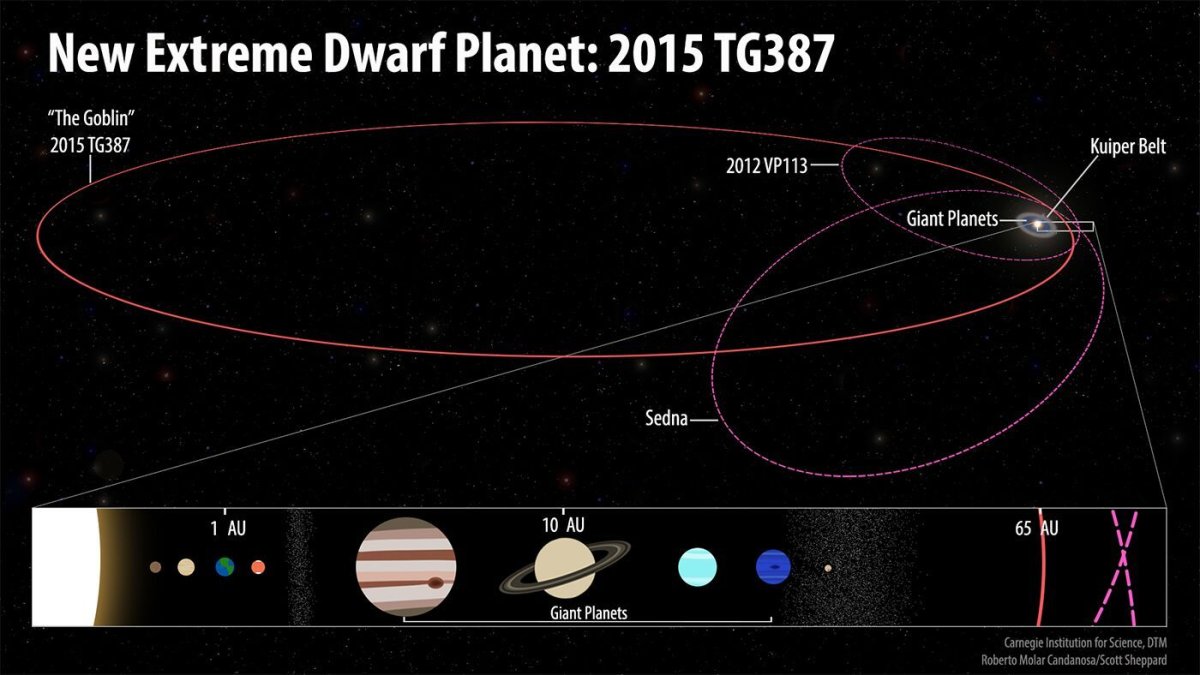Scientists have discovered a weird 190-mile-wide space rock that adds even more evidence for the existence of 'Planet Nine'—a mystery 'super-Earth' planet believed to be lurking right at the edge of the solar system.
The new "extreme dwarf planet" 2015 TG387 has been dubbed The Goblin. It is one of three Inner Oort Cloud (IOC) objects that have been discovered in the last decade—the other two, 2012 VP113 and Sedna, helped researchers build a case for Planet Nine because of their unusual orbits.
Because these objects are so far away from the Sun and the other planets, they are less affected by the gravitational force they exert. Instead, these objects appear to be under the influence of another massive planet—their unusual elongated orbits could be explained by a large yet-to-be-discovered planet.
Scott Sheppard, from Carnegie Institution for Science, and colleagues announced the discovery of the Goblin at the International Astronomical Union's Minor Planet Center. Their study has been submitted for publication in the Astronomical Journal.

2015 TG387 was discovered when it was around 80AU (astronomical units) from the Sun—that's over seven billion miles. One AU is the distance between Earth and the Sun, which is about 93 million miles.
It was first spotted in October 2015. astronomers spent the next three years watching it and confirming its orbit. Observations show it is a small dwarf planet with a diameter of around 190 miles and that it travels along an elongated orbit. At its farthest point, it is 2,300 AU from the Sun, and at its closest, it is 65AU.
"We think there could be thousands of small bodies like 2015 TG387 out on the Solar System's fringes, but their distance makes finding them very difficult," study author David Tholen, from the University of Hawaii, said in a statement. "Currently we would only detect 2015 TG387 when it is near its closest approach to the Sun. For some 99 percent of its 40,000-year orbit, it would be too faint to see."

The Goblin was found as part of the ongoing effort to find Planet Nine. This is a hypothetical planet that has been proposed to exist for many years, but evidence of which has only just started to emerge. It is believed to be a "super-Earth" with a mass about ten times that of our home planet. How and why it ended up at the end of the solar system is not known. Some scientists suggest it started off in the inner solar system but was, at some point, pushed out by the other planets. Others think it could be a planet that once belonged to another solar system and was hijacked by the gravitational pull of the Sun.
The ongoing project to find Planet Nine is the biggest and deepest survey of distant solar system objects ever conducted. "These distant objects are like breadcrumbs leading us to Planet Nine," Sheppard said.
Computer simulations revealed that 2015 TG387's orbit was stable and that it was being controlled by Planet Nine's gravity. Chad Trujillo, from Northern Arizona University, said: "What makes this result really interesting is that Planet X seems to affect 2015 TG387 the same way as all the other extremely distant Solar System objects. These simulations do not prove that there's another massive planet in our Solar System, but they are further evidence that something big could be out there."
Sheppard added: "The more of them we can find, the better we can understand the outer Solar System and the possible planet that we think is shaping their orbits—a discovery that would redefine our knowledge of the Solar System's evolution."

Andrew Coates, Professor of Physics at University College London, who was not involved in the research, told Newsweek the findings add more weight to the idea there is a hidden planet at the far reaches of the solar system. "It looks like the evidence is mounting for a distant, unseen Planet Nine," he said. "This newly discovered object TG387, or The Goblin, is only the third IOC object to be found."
He said the orbits of IOCs are like sensitive "probes" of objects in the outer solar system: "The orbits of these objects, including TG387, show 'clustering' with their closest distances to the Sun at a particular longitude. The paper uses simulations over the age of the solar system, showing that TG387's orbit is most easily explained if there really is an unseen Planet Nine lurking in the outer solar system.
"The hunt is now on to find such an object, if it exists, as well as more IOCs. Although the number of IOCs detected so far is only three, and there are only seven objects seen so far that show the clustering, their orbits may mean that our solar system needs a new, unseen planet."
Uncommon Knowledge
Newsweek is committed to challenging conventional wisdom and finding connections in the search for common ground.
Newsweek is committed to challenging conventional wisdom and finding connections in the search for common ground.
About the writer
Hannah Osborne is Nesweek's Science Editor, based in London, UK. Hannah joined Newsweek in 2017 from IBTimes UK. She is ... Read more
To read how Newsweek uses AI as a newsroom tool, Click here.








